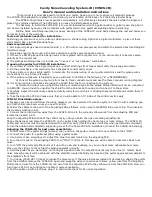
Applications
4-11
4.9
Static charge detection
Electrostatic charge is a deficiency or excess of electrons on
an ungrounded surface. Such charges are usually generated
on poor conductors of electricity such as plastics, synthetic
fibers, and paper during handling or processing of these ma-
terials. Once these charges accumulate, they do not dissipate
readily because of the excellent insulating characteristics of
the materials involved.
Static charge build-up can be a problem with integrated cir-
cuits, especially with those of the CMOS variety. While
these devices, which operate at high impedance levels, often
have static protection built in, it is best to properly protect
them during transit or storage. For that reason, such ICs are
usually shipped and stored in anti-static tubes.
A primary consideration, then, is the degree of static protec-
tion afforded by the anti-static tube. A comparison among
various tubes can be set up to test the variations in charge
build-up as a particular IC slides the length of the tube. The
charge value will, of course, be measured by the Model 6512
being operated in the coulombs function.
To perform this test, a test fixture called a Faraday cup will
be necessary. Such a fixture can be easily constructed from
two cans, as shown in Figure 4-11. For example, the outer
can could be a one-gallon paint can, while the inner cylinder
could be one of slightly smaller diameter, such as a quart
paint can. The two cans must be insulated from one another.
Although the type of insulator is not all that critical, ceramic
or Teflon insulators can be used.
For convenience, a BNC connector could be mounted on the
outside can. The outer, or shield connection will, of course,
be connected to the outer can, while the inner conductor
should be connected to the inner can.
To perform the test, connect the Model 6512 to the Faraday
cup using a suitable shielded cable, such as Model 4801
BNC cable. A Model 7078-TRX-BNC triax-to- BNC adapter
will be required to make the connection. With the instrument
in the coulombs mode, place a typical IC in the tube to be
tested; allow it to slide the full length of the tube and fall into
the Faraday cup. The amount of charge built up during the
test will then be registered on the Model 6512.
The test can be repeated with other tubes, as required. In order
for the test to be valid, all tubes should be the same length, and
the same IC should be used in every case. The tube that gener-
ates the smallest static charge as seen on the electrometer is the
one with the best anti-static characteristics. The amount of
charge seen during this test will depend on many factors, in-
cluding the type of tube material, tube length, the IC used, as
well as the relative humidity. Typical values might be in the
0.5-1nC range for a good anti-static tube, while one without
anti-static protection might generate 10 times that amount.
Figure 4-10
Faraday cup construction
LO
TOP VIEW
SIDE
VIEW
INNER
CYLINDER
BNC
CONNECTOR
INSULATORS
(TEFLON OR CERAMIC)
OUTER
CYLINDER
Summary of Contents for 6512
Page 119: ...Maintenance 7 10 Figure 7 5 Exploded view...
Page 131: ......
















































